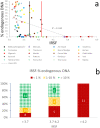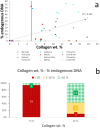Screening archaeological bone for palaeogenetic and palaeoproteomic studies
- PMID: 32584871
- PMCID: PMC7316274
- DOI: 10.1371/journal.pone.0235146
Screening archaeological bone for palaeogenetic and palaeoproteomic studies
Abstract
The recovery and analysis of ancient DNA and protein from archaeological bone is time-consuming and expensive to carry out, while it involves the partial or complete destruction of valuable or rare specimens. The fields of palaeogenetic and palaeoproteomic research would benefit greatly from techniques that can assess the molecular quality prior to sampling. To be relevant, such screening methods should be effective, minimally-destructive, and rapid. This study reports results based on spectroscopic (Fourier-transform infrared spectroscopy in attenuated total reflectance [FTIR-ATR]; n = 266), palaeoproteomic (collagen content; n = 226), and palaeogenetic (endogenous DNA content; n = 88) techniques. We establish thresholds for three different FTIR indices, a) the infrared splitting factor [IRSF] that assesses relative changes in bioapatite crystals' size and homogeneity; b) the carbonate-to-phosphate [C/P] ratio as a relative measure of carbonate content in bioapatite crystals; and c) the amide-to-phosphate ratio [Am/P] for assessing the relative organic content preserved in bone. These thresholds are both extremely reliable and easy to apply for the successful and rapid distinction between well- and poorly-preserved specimens. This is a milestone for choosing appropriate samples prior to genomic and collagen analyses, with important implications for biomolecular archaeology and palaeontology.
Conflict of interest statement
The authors have declared that no competing interests exist.
Figures




References
Publication types
MeSH terms
Substances
Associated data
LinkOut - more resources
Full Text Sources
Miscellaneous

